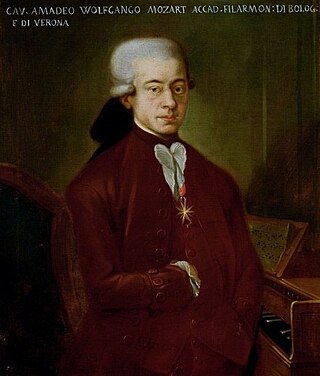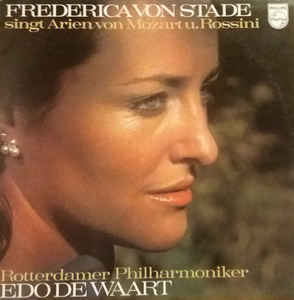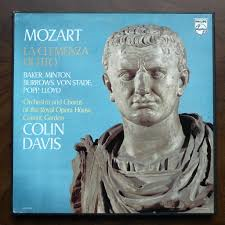History
The rondò became the most fashionable showpiece aria type in Italian opera during the last three decades of the 18th century. Although Mozart was far from being the first composer to use the rondò, he was certainly the most important. He refined and deepened the form, particularly by creating smoother transitions between the slow and fast sections. He first adopted it for Belmonte’s "Wenn der Freude Tränen fliessen" in his 1782 Singspiel Die Entführung aus dem Serail . Subsequently he began using them in opera seria , first in the 1786 revival of Idomeneo , when he inserted a new aria, "Non temer, amato bene", in rondò form. In the same year he provided another one for Der Schauspieldirektor , and initially sketched (but ultimately rejected using) a rondò for Susanna's garden aria in Le nozze di Figaro . Two later Mozart operas with rondòs are Don Giovanni and Così fan tutte (Fiordiligi’s “Per pietà, ben mio, perdona”). For his last opera, La clemenza di Tito , Mozart wrote a pair of rondòs: Vitellia’s "Non più di fiori" and Sesto’s "Deh per questo istante".
Other notable composers of the period to compose rondòs include Giuseppe Sarti ( Giulio Sabino , 1781) and Domenico Cimarosa, whose Olimpiade (1784) includes two long rondòs for the prima donna , Aristea, and the primo uomo, Megacle. The longer of the two goes to the hero in the penultimate scene of the opera. Joseph Haydn employed the form in 1784 for the aria "Dei pietosi" in Armida . [5]
The rondò is distinct from the refrain form called rondo. [6] In recent English and German musical literature, the Italian spelling and pronunciation (with accent on the last syllable) has been adopted to distinguish this from the (predominantly instrumental) form called rondo (with accent on the first syllable). No such distinction was made in the late 18th century when this vocal type flourished; the spellings rondo, rondò, rondeau, rondeaux, and even rondieaoux were used indiscriminately for both musical forms. [7]
The leading feature of the rondò as a form is its division into two sections with contrasting tempos. The opening part is slow, and presents a theme that often returns after a contrasting section to form an ABA pattern. This is followed by a concluding faster part, beginning either with a new theme or with a faster variation of the slow section’s main theme. Sometimes the text associated with the main theme of the slow section recurs in the second half as well. In the opera, these arias are generally assigned only to the prima donna or primo uomo and are strategically placed in or near the concluding scene or else (in a three-act opera) as the final number of the second act. [8]
The form is similar to, and may have developed from the compound binary form (ABA'B'), with an added faster coda, called a stretta (ABA'B':CC'), a variant form of the rondò found in Mozart's "Non mi dir" from Don Giovanni (1787). Another possible antecedent is a truncated variant of an ABABA refrain-form rondo, in which the final refrain is omitted and the A and B sections are given contrasting slow-fast tempos—a form favoured by the Neapolitan poet Saverio Mattei and which is found in "Non ho colpa" from Mozart's Idomeneo . [9] The repetitions of themes within each section was an invitation for the singer to add virtuoso embellishments upon its return.
Text
Rondò texts usually employ an elevated rhetorical style and are almost always either laments of unhappy lovers or conventional calls to love. As a result, they are rather generalised and conventional in expression, detached and distant emotionally, so that they are easily transferable from one opera libretto to another, as happened with "Non tardar amato bene", rejected by Mozart for Le nozze di Figaro and recycled by his librettist, Lorenzo Da Ponte for another opera, Il demogorgone, ovvero il filosofo confuso, set by Vincenzo Righini.
While there are examples of two-strophe rondòs through most of its period of popularity, the poetry far more often consists of three quatrains of ottonario, with the third quatrain usually shifting mood or dramatic focus in order to justify a new musical section. The slow part of the music sets the first two quatrains in an ABA pattern. The fast music uses the final quatrain for its main theme, and repeats parts of the earlier text (most often from the second quatrain) for the contrasting material. In later examples, where the fast sections become longer and more complex, material from all three stanzas came to be used. [9]

In music, an aria is a self-contained piece for one voice, with or without instrumental or orchestral accompaniment, normally part of a larger work.

The rondo is a musical form that contains a principal theme which alternates with one or more contrasting themes, generally called "episodes", but also occasionally referred to as "digressions" or "couplets". Some possible patterns include: ABACA, ABACAB, ABACBA, or ABACABA.

Eine kleine Nachtmusik, K. 525, is a 1787 composition for a chamber ensemble by Wolfgang Amadeus Mozart (1756–1791). The German title means "a little night music". The work is written for an ensemble of two violins, viola, cello and double bass, but is often performed by string orchestras. The serenade is one of Mozart's most famous works.

Opera seria is an Italian musical term which refers to the noble and "serious" style of Italian opera that predominated in Europe from the 1710s to about 1770. The term itself was rarely used at the time and only attained common usage once opera seria was becoming unfashionable and beginning to be viewed as something of a historical genre. The popular rival to opera seria was opera buffa, the 'comic' opera that took its cue from the improvisatory commedia dell'arte.
In Western classical music, obbligato usually describes a musical line that is in some way indispensable in performance. Its opposite is the marking ad libitum. It can also be used, more specifically, to indicate that a passage of music was to be played exactly as written, or only by the specified instrument, without changes or omissions. The word is borrowed from Italian ; the spelling obligato is not acceptable in British English, but it is often used as an alternative spelling in the US. The word can stand on its own, in English, as a noun, or appear as a modifier in a noun phrase.

La clemenza di Tito, K. 621, is an opera seria in two acts composed by Wolfgang Amadeus Mozart to an Italian libretto by Caterino Mazzolà, after Pietro Metastasio. Mozart began the work while he was finishing Die Zauberflöte, the last of his principal operas. La clemenza di Tito premiered on 6 September 1791 at the Estates Theatre in Prague.

The Bassoon Concerto in B-flat major, K. 191/186e, is a bassoon concerto written in 1774 by Wolfgang Amadeus Mozart. It is the most often performed and studied piece in the entire bassoon repertory. Nearly all professional bassoonists will perform the piece at some stage in their career, and it is probably the most commonly requested piece in orchestral auditions – it is usually requested that the player perform excerpts from the concerto's first two movements in every audition.

Symphony No. 35 in D major, K. 385, also known as the Haffner Symphony, was composed by Wolfgang Amadeus Mozart in 1782. It was commissioned by the Haffners, a prominent Salzburg family, for the occasion of the ennoblement of Sigmund Haffner the Younger. The Haffner Symphony should not be confused with the eight-movement Haffner Serenade, another piece Mozart wrote on commission from the same family in 1776.

The Violin Concerto No. 5 in A major, K. 219, often referred to by the nickname "Turkish", was written by Wolfgang Amadeus Mozart in 1775, premiering during the Christmas season that year in Salzburg. It follows the typical fast–slow–fast musical structure.

AnnaSelina Storace, known professionally as Nancy Storace, was an English operatic soprano. The role of Susanna in Mozart's Le nozze di Figaro was written for and first performed by her.
A catalogue aria is a genre of opera aria in which the singer recounts a list of information that was popular in Italian comic opera in the latter half of the eighteenth and early nineteenth centuries.
The Milanese Quartets, K. 155–160, are a set of six string quartets composed by Wolfgang Amadeus Mozart in late 1772 and early 1773 when he was sixteen and seventeen years old. They are called 'Milanese' because Mozart composed them in Milan while he was working on his opera Lucio Silla. Before this set was composed, Mozart had written one earlier string quartet, so these six quartets are numbered from No. 2 to No. 7. The quartets are written in a plan of keys of D–G–C–F–B♭–E♭ following the circle of fourths.
"Ch'io mi scordi di te? ... Non temer, amato bene", K. 505, is a concert aria by Wolfgang Amadeus Mozart for soprano, piano obbligato and orchestra, composed in December 1786 in Vienna.

La Nitteti is an 18th-century Italian opera in 3 acts by the Czech composer Josef Mysliveček. It was composed to a libretto by the Italian poet Metastasio that was first performed in 1756, one of the newer of the Metastasian librettos in Mysliveček's day. For a performance in the 1770s, it would only be expected that a libretto of such age would be abbreviated and altered to suit contemporary operatic taste. This opera contains more substitutions of original aria texts than any other Mysliveček setting of a Metastasian libretto. The cuts and changes in the text made for the 1770 performance of Mysliveček's opera are not attributable. All of Mysliveček's operas are of the serious type in Italian language referred to as opera seria.

Antigono is an 18th-century Italian opera in 3 acts by the Czech composer Josef Mysliveček composed to a libretto by the Italian poet Metastasio first produced in 1744 with music of Johann Adolf Hasse. This opera belong to the serious type in Italian language referred to as opera seria. For a performance in the 1780s, it would only be expected that a libretto by Metastasio would be abbreviated and altered to suit contemporary operatic taste. The cuts and changes in the text made for the performance of Mysliveček's version are not attributable.

La clemenza di Tito is an 18th-century Italian opera in 3 acts by the Czech composer Josef Mysliveček. It was composed to a libretto by the Italian poet Metastasio that was first performed in 1734 with music of Antonio Caldara. For a performance in the 1770s, it would only be expected that a libretto of such age would be abbreviated and altered to suit contemporary operatic taste. The cuts and changes in the text made for the 1774 performance of Mysliveček's opera are not attributable. All of Mysliveček's operas are of the serious type in Italian language referred to as opera seria.

Frederica von Stade sings Mozart & Rossini Arias is a 52-minute studio album of operatic arias performed by von Stade and the Rotterdam Philharmonic Orchestra under the direction of Edo de Waart. It was released in 1976. A second, 69-minute version of the album, Frederica von Stade: Haydn, Mozart & Rossini Arias, released by Philips on CD, adds bonus tracks derived from von Stade's contributions to Antal Doráti's recordings of Joseph Haydn's operas La fedeltà premiata and Il mondo della luna. A third, 52-minute version released on SACD by PentaTone in 2005 reverts to the contents of the first version, but presents the music in quadraphonic surround sound.

La clemenza di Tito is a 127-minute studio album of the opera by Wolfgang Amadeus Mozart, performed by Dame Janet Baker, Stuart Burrows, Robert Lloyd. Yvonne Minton, Lucia Popp and Frederica von Stade with the Chorus and Orchestra of the Royal Opera House, Covent Garden, under the direction of Sir Colin Davis. It was released in 1977.
"Non più. Tutto ascoltai...Non temer, amato bene", K. 490, is a concert aria by Wolfgang Amadeus Mozart for solo tenor and orchestra, composed in Vienna in 1786. Originally written for the tenor voice, the aria is mostly now performed by sopranos. The text of this aria is taken from Mozart's 1781 opera Idomeneo, by Giambattista Varesco. The aria was published by Breitkopf & Härtel in 1881.









